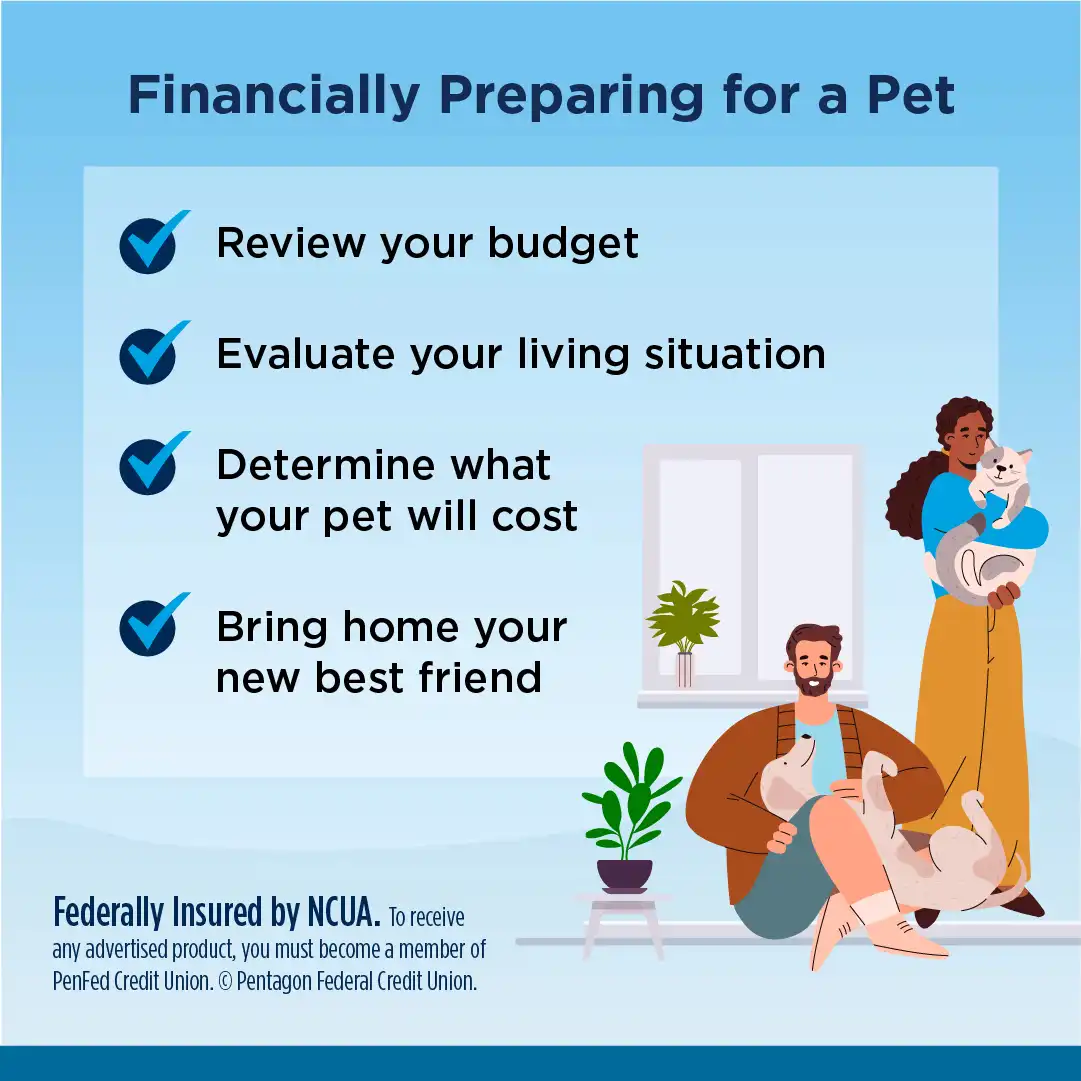4 Ways to Financially Prepare for a Pet
EXPECTED READ TIME: 6 MINUTES
Few things are as exciting as bringing home a new pet. You’re probably thinking about all the love, fun, and tail wags coming your way.
But are you also thinking about the expenses? According to the American Pet Products Association, Americans spent over $100 billion on pet products in 2020. That’s not surprising given that pet ownership is rising — and with it, the cost of pet ownership.
We’ll help you financially prepare for your new best friend.

1. Review Your Budget
Pets can be surprisingly expensive, and you don’t want to end up in debt or have to give up your pet because of costs. If you’re not sure if you’re financially ready for a pet, ask yourself if you:
- Have a budget and consistently stick to it ·
- Regularly put money into separate savings and emergency funds
- Manage any debt you have
- Have disposable income to support a pet
2. Evaluate Your Living Situation
You may need to modify your home before adopting a pet. For example, you might patch or put up a fence or buy pet-proof cord protectors. These modifications come with costs. Plus, don’t forget about pet fees, pet deposits, and pet rent if you’re renting.
You may need to modify your home before adopting a pet.
3. Determine What Your Pet Will Cost
The species, breed, age, size, and health of your pet will determine how expensive it is to care for. All pets are different, but here are some common costs to consider:
Daily Care Costs
These are day-to-day costs of keeping your pet happy and healthy, including:
- Food
- Environment (litter, bedding, tanks, heated rocks, water treatment, etc.)
- Grooming
- Training
- Enrichment (toys, treats, beds)
Research the kind of vet care your pet will need, what it costs, and how often they’ll need that care.
Vet Costs
Research the kind of vet care your pet will need, what it costs, and how often they’ll need that care. Common expenses include:
- Vaccines
- Annual check-ups
- Flea and parasite prevention
- Supplements (for fish, reptiles, and amphibians)
- Medication for short- or long-term illnesses
- Medication for age-related conditions (such as arthritis)
Pet insurance offsets the cost of medical treatment if your pet is ill or injured.
Pet Insurance
Pet insurance offsets the cost of medical treatment if your pet is ill or injured. As of 2022, the average annual cost of a policy is $640 for dogs and $387 for cats, or $53 per month and $32 per month respectively. However, premiums vary widely depending on the age, breed, and gender of your pet.
Plans come with annual deductibles. After the deductible is met, the plan pays a percentage of your vet costs up to your annual limit. Importantly, pet insurance doesn’t cover:
- Preventative care
- Spay or neuter surgery
- Annual check-ups
- Teeth cleaning
That means most routine care pet owners pay for each year isn’t covered. Also, pre-existing conditions are not covered and may raise your premiums. However, pet insurance can save you thousands of dollars if your pet becomes seriously ill.
Pet insurance can save you thousands of dollars if your pet becomes seriously ill.
4. Explore Alternatives to Pet Insurance
Pet insurance could save you money, or you could pay on a policy for years and never use it. If you decide it isn’t for you, there are alternative ways to protect your pet.
Create a Pet Emergency Fund
A pet emergency fund is a great alternative to pet insurance because it:
- Keeps your money liquid
- Earns compound interest that grows your savings
- Doesn’t have restrictions or limitations
Note: You and your pet should have separate emergency funds so if disaster strikes twice, you’re both covered.
Certificates
Certificates can be an effective way to save for your pet’s old age, especially if you start when your pet is young — or even before you adopt them. You’ll have time to implement certificate strategies and grow a nest egg to cover issues they face as they age.
Make the most from a bad situation and use a rewards card.
Low-APR Credit Card
If you’re comfortable managing credit, another option is your trusty credit card. You already have it and know how it works, so there won’t be surprises or restrictions. Choose a low-APR card with no annual fee like the PenFed Gold Visa Card to keep your costs low, or make the most from a bad situation and use a rewards card.
Pet Insurance Compared to Alternatives
|
|
Monthly Costs? |
Deductible? |
Restrictions on coverage or routine care? |
Restrictions on pre-existing conditions? |
|---|---|---|---|---|
|
Pet Insurance |
Premium that increases with age |
Yes |
Yes |
Yes |
|
Emergency Fund |
You decide how much to save |
No |
No |
No |
|
Certificates |
Initial deposit (usually minimum of $1,000) |
No |
No |
No |
|
Credit Card |
APR on balances carried month-to-month |
No |
No |
No |
Bring Home Your New Best Friend
Adopting from a shelter is the cheapest option. Shelters usually charge an adoption fee, although fees may be waived during special adoption events. Pets from local shelter or breed rescues come vaccinated and spayed/neutered. Pets who are too young to be fixed usually come with a spay/neuter voucher that reduces or eliminates this cost.
Pets who are too young to be fixed usually come with a spay/neuter voucher that reduces or eliminates this cost.
Purebreds and designer breeds can be many times the cost of shelter pets. They’re less likely to have been vaccinated and will almost never come fixed, leaving you on the hook for those costs. Additionally, you may have to factor in travel costs if the breed you want isn’t popular in your area.
Factor in travel costs if the breed you want isn’t popular in your area
Vaccinations and Spaying/Neutering
Vaccinations for a new dog or cat can range anywhere from $20 to $50 per vaccine with many states requiring:
- Four core vaccinations and three recommended vaccines for dogs
- Four core vaccinations and one recommended vaccine for cats
Most vets recommend spaying or neutering your pet. The cost of these procedures depends on the size, age, and gender of your pet and where you have it done. Some shelters run specials charging as little as $20, but average costs run from $75-$250.
The Takeaway
The first big step in caring for your furry friend is ensuring they have a stable home. And now that you’re a pro at managing the finances of pet ownership, you’re well on your way to being an excellent pet parent.
Bank With Confidence
Discover the diverse offering of products, services, and support available to our members.




